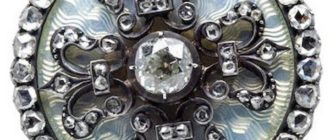
Embossing is a type of decorative and applied art in which the artist knocks out a relief image on sheet metal with a special tool. Coinage can rightfully be called a traditional masculine craft, because to create even a small masterpiece, a master has to put in considerable physical effort.
Embossing, along with forging, casting and engraving, is also one of the oldest techniques in the artistic processing of metal. This craft requires great patience, perseverance and attentiveness from the master, but it provides him with tremendous opportunities for creative self-realization.

Types and features of minting
Chasing is traditionally used to make all kinds of decor and beautiful tableware, but talented artists use this technique to create other works of art as well:
- original paintings and jewelry; huge sculptures and monuments;
- magnificent armor and frames for icons;
- frames for mirrors and chests;
- book covers and helmets;
- edged weapons and chain mail;
- candlesticks and candelabra;
- smoking appliances and kitchen utensils;
- lanterns and lamps;
- decorative fences and lattices;
- belts and shields.
Depending on the peculiarities of the metal processing technique, the following types of minting are distinguished:
- openwork;
- contour;
- volumetric.
Openwork embossing is the most common type of artistic metal processing, which is used to apply a relief image to most of the surface of a product. Contour chasing is used to make original ornaments along the edge of blanks, and volume chasing is used to create large-scale sculptural compositions and monuments.
A variety of metals and their alloys can serve as a material for the production of embossing.

Most often, masters use sheets for artistic processing:
- copper;
- brass;
- aluminum;
- of stainless steel;
- cupronickel;
- nickel silver.
For the manufacture of jewelry and the most expensive decor items, chasers use precious metals, namely silver and gold. But craftsmen rarely work with these materials, much more often finished products made of copper or brass are simply covered with the thinnest layer of gilding to give them a characteristic shine.

History of minting
The history of minting spans a huge period of time from the early Bronze Age to the present day and has about five and a half millennia. As a result of numerous archaeological excavations, it has been reliably established that even in the middle of the fourth millennium BC this method of artistic metal processing was familiar to the masters of the most ancient civilizations of Europe, Asia and Africa.
Egyptian minters learned to make magnificent death masks from gold for pharaohs no later than the beginning of the third millennium BC. One of them, intended for the famous Tutankhamun, today is the most valuable example of the collection of artifacts of the Museum of Antiquities in Cairo.
In Ancient Greece, and then in the Roman Empire, the chasing of military armor and shields reached a high level of skill. Along with this, local chasers were engaged in artistic processing of various household items and decor.

Over time, unique schools of artistic coinage have formed in various parts of the world:
- iIndia and Central Asia;
- China and Japan;
- the Americas;
- all regions of Europe.
For many millennia, the art of chasing remained in demand in the production of a wide variety of jewelry, décor and household items. This was largely due to the important advantages of the ancient metalworking technique: the availability of materials and necessary tools; almost complete absence of metal waste in the production process; durability and excellent appearance of the manufactured items.
In the 19th century, coinage began to be widely used in monumental art. A striking example of the veracity of these words is the most famous symbol of New York and all of America – the Statue of Liberty, made of minted thin sheets of copper.
In the USSR, thousands of chasers for many decades, on the instructions of the state, worked hard to create majestic monuments and monuments dedicated to the October Revolution, the Great Patriotic War and the achievements of Soviet power. The results of their work can still be seen firsthand in hundreds of settlements in Russia and the countries of the former Soviet Union.
And in the 21st century, chasing remains the most popular technique for artistic metalworking. At art auctions, the masterpieces of ancient masters invariably arouse great interest among potential buyers, and the works of the best contemporary artists are sold for huge sums of money to collectors from different countries.
Embossing products










